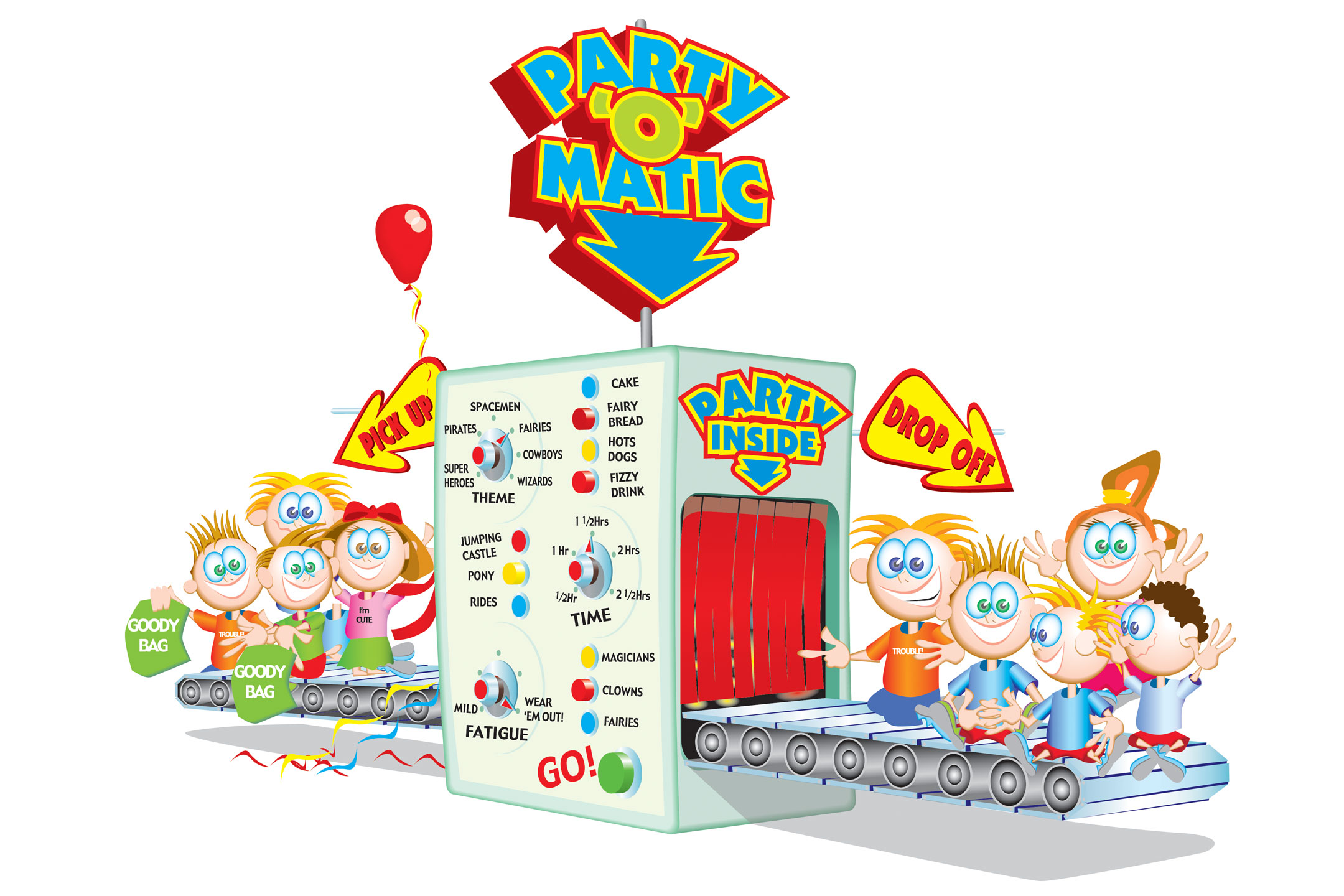
06 Jun Behind The Birthday Bash
We all enjoy a good party, and Ruth Wajnryb reminds us of their primary purposes.
Nostalgia is a funny thing—funny-peculiar, not funny, ha-ha. Once you’re on a jaunt down memory lane, it’s easy to get carried away. Take children’s birthday parties, for instance.
When I was raising my children (the eldest is now 40), birthday parties were compulsory, and their format was ritualistic. The children arrived on time, and parents scrambled away to enjoy a window of ‘me’ time. Entertainment was in the form of party games, such as Simon Says, Statues, Musical Chairs, Pass The Parcel and Pin The Tail On The Donkey. The food was conventional: fairy bread, cupcakes, chocolate crackles, cocktail frankfurts and sauce. Then – drum roll – out came the cake and candles, accompanied by the ‘Happy Birthday’ song, Happy snaps were taken, and take-home lolly bags were handed out as parents arrived for pick-up. And lastly, there was the comedown: red-food-colouring after-effects and exhaustion all round.
Inevitably, this formula has changed over time. Early changes to parties crept in with commercial food venues. The kids loved the added excitement that such venues could offer, and the parental workload fell dramatically. Yearly, choice and possibility grew. We’re now more affluent, more competitive, live at a faster pace, less relaxed, and more global but less communal. Life offers us a near-overwhelming range of options in the face of rampaging waves of change.
Yet you can still have a simple celebration for the birthday child (BC), with a small group of the child’s friends invited to your home, along with grandparents and other members of the extended family. There can be presents, cake and candles, old-fashioned games, and many other traditional elements that have always made a party special for kids.
Or you can ‘go to town’, where the choices are almost infinite. These mostly involve outsourcing some or all of the work involved, such as catering and entertainment, and even the venue. Choose a theme; have fairies, superheroes (or a mix of the two), clowns, jugglers, balloons, face painting, fairy floss, dress-ups, whatever. You can take the kids out or even hire an island and play modern-day pirates. You can go skating, horse riding, bowling, have a picnic or go to an amusement park. You can do painting, ceramics, and craft activities. There’s no shortage of ideas.
 While outsourcing parties can attract criticism, this is often unwarranted. After all, technologically, we’ve moved on from donkeys’ tails. Many of us are time-poor but not necessarily cash-poor. We’d rather make a donation than a cake for the charity fete. We already outsource much about our lives—cleaning, gardening, the swimming pool, IT, ironing, fitness training, and the kids’ homework help. Some of us even have life coaches to help us outsource.
While outsourcing parties can attract criticism, this is often unwarranted. After all, technologically, we’ve moved on from donkeys’ tails. Many of us are time-poor but not necessarily cash-poor. We’d rather make a donation than a cake for the charity fete. We already outsource much about our lives—cleaning, gardening, the swimming pool, IT, ironing, fitness training, and the kids’ homework help. Some of us even have life coaches to help us outsource.
So, where do we draw the line? When does ‘much’ become ‘too much’? How do we sidestep the competitive rhythm of bigger, better, showier parties, where the number of presents received is seen as an index of our child’s popularity?
In essence, this amounts to keeping sight of one’s core values and one’s overall purpose and being aware that these require some forethought and planning. Never lose sight of the fact that the central objective is to celebrate a child’s being alive and, in the process, to host an event at which others of different ages can connect.
Here’s what I call the 3S formula – Safe, Social and Special.
These three factors are outlined discretely below, but they are intertwined.
Nothing good comes of a party that compromises people’s well-being. Good professional party entertainers take a proactive stance on safety because they are obliged to consider Occupational Health and Safety issues as part of the job.
Notwithstanding the age of the guests, emotions can run high, and the smallest incident can act as a trigger. Things can brew quietly before seeming to explode suddenly. So, keep an eye, unobtrusively, on every child invited to ensure that each is safe and happily involved. If the partygoers come from different parts of BC’s life, some ice-breaking activities may help the children mingle so that no one is left out. Troubleshoot before the trouble erupts.
A rule of thumb: less is more.
The bigger the numbers, the bigger the crowd-control and safety issues. The presence of the guests’ parents at children’s parties can have both pluses and minuses. The parents can be unhelpful, interfering and overly precious about their own children. On the other hand, they can make themselves available to the host, being helpful and tactfully monitoring all of the children so that accidents can be averted. People usually respond well to discreet suggestions and instructions. You, as host, set the tone.
You should also find out if any of the guests have allergies and, if so, what precautions or actions are required. Ensure that you have accurate contact information for parents who won’t be staying at the party. Consider the ratio of ‘helper’ adults to children so that children can be safely monitored and alert everyone to out-of-bounds areas of the home and garden.
Part of our current notion of a ‘special’ day is to create differences between it and the other days of the year.
One special feature of the given day is the giving and receiving of presents. The gift is ritualistic; it’s part of the complex social world of birthday parties. However, effort is required to avoid present-giving being about ‘bigger and better’. The point of the event isn’t acquisition, as suggested by words such as ‘booty’ or ‘loot’. It’s useful to formulate a policy in advance and let people know about it. This can sometimes be done collectively, involving, say, the child’s particular friendship group or even the school class.
Because gift-giving is essentially social, it helps to invest the gift with an appropriate significance. It’s lovely when a present shows personal thought. I recall the parent of a friend of my daughter who filled up a little photo book (from a $2 shop) with photos of the two girls, taken over the previous months, along with recipes of food that the mother had cooked and knew my daughter liked. Some of the photos had ‘bubbles’ for writing thoughts in, and the girls wrote in them. This present was low-cost but high appeal, and we still have it. Another time, this friend’s present came after the party, and again, it was a photo book filled with party pics, with the names of the children and close-ups of the cake, all recorded for posterity. It was low-cost, personal and no whizz-bang arts-and-crafts skills were required.
 Again, because gift-giving and receiving is social, the BC needs to be trained to accept gifts graciously and guided in conventional ‘thanking’ processes. Ignore all grumbling and enforce the conventions of basic politeness – rehearse the BC in how to receive gifts politely, and create opportunities for short letters of thanks or emails to be written after the party. Both my children grumbled about this every birthday of their childhood, but I overruled them and pressed on. They’ve both emerged as young adults with well-developed politeness skills; neither needs reminding now, it seems to come naturally.
Again, because gift-giving and receiving is social, the BC needs to be trained to accept gifts graciously and guided in conventional ‘thanking’ processes. Ignore all grumbling and enforce the conventions of basic politeness – rehearse the BC in how to receive gifts politely, and create opportunities for short letters of thanks or emails to be written after the party. Both my children grumbled about this every birthday of their childhood, but I overruled them and pressed on. They’ve both emerged as young adults with well-developed politeness skills; neither needs reminding now, it seems to come naturally.
And it’s not only in the receiving of gifts that politeness matters. Every aspect of the social world of a party requires good manners, which is shorthand for considering others’ feelings. For example, if the whole class is not invited, invitations should not be given out at school. Your child should also know that bragging and boasting are antisocial behaviours. Have a no-loser policy at the party: keep the activities non-competitive or have prizes for everyone.
A child’s birthday is the highlight of their year.
They are special, very special, for one whole day. Your role as a parent is to find some balance between making the day special for the child and overwhelming them and their peers. Be wary of confusing ‘special’ with ‘superior’ because the latter is antisocial and will not serve anyone – the BC, the group or the wider community.
Remember that excess comes with its own costs, such as an inability to appreciate things and an inflated sense of entitlement. I never told my son this, but every birthday, I squirrelled away some of the presents he received and brought them out much later. The day was still special; he still savoured all of it, but he was spared the excess, which he came to enjoy at staggered points throughout the following year.
The party is about the BC, but it is not about them only. It’s a social event where other people of different ages and different relationships with the BC contribute to and share in the festivity. You surely don’t want your child to feel special at the expense of any other.
At the end of the day, a successful party is not the one that brings in the best ‘booty’, or that takes place at the most exciting venue, but the one that succeeds in both its personal and social functions without compromising either.
Illustrations by Giles Evans


